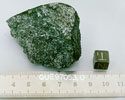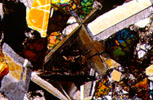
| MetSoc Home Publications Contacts |
 |
||
|
||
| Queen Alexandra Range 97053 | |||||||||||||||||||||
|---|---|---|---|---|---|---|---|---|---|---|---|---|---|---|---|---|---|---|---|---|---|
| Basic information | Name: Queen Alexandra Range 97053 This is an OFFICIAL meteorite name. Abbreviation: QUE 97053 Observed fall: No Year found: 1997 Country: Antarctica [Collected by US Antarctic Search for Meteorites program (ANSMET)] Mass:  75.1 g 75.1 g | ||||||||||||||||||||
| Classification history: |
This is 1 of 136 approved meteorites classified as Eucrite-unbr. [show all] Search for other: Achondrites, Eucrites, and HED achondrites | ||||||||||||||||||||
| Comments: | Field number: 9823 | ||||||||||||||||||||
Writeup |
Writeup from AMN 22(1):

Macroscopic Description: Kathleen McBride The exterior of this broken piece has fusion crust on approximately 50% of its surface. The fusion crust is very black and shiny with striations. The exposed interior is fine-grained with black and white matrix and with medium brown inclusions. The interior has black and white granular crystals and dark grains of pyroxenes. Transparent to translucent plagioclase grains are visible. There is very minor rust or root beer colored grains near the exterior. Thin Section (, 2) Description: Tim McCoy 
The section consists of mm-sized grains of pyroxene and plagioclase. Pyroxene is pigeonite to subcalcic augite in composition (Fs41.2-49 Wo6.5-24.5) with an Fe/Mn ratio of about 30. Many grains are twinned on a very fine scale with augite lamellae of <= 2μm in width. Plagioclase has a composition of An79-89. Shock effects are pervasive, including mosaicism in pyroxene and undulatory extinction in plagioclase. The meteorite is an unbrecciated eucrite. | ||||||||||||||||||||
| Data from: MB83 Table A1 Line 368: |
|
||||||||||||||||||||
| Catalogs: |
| ||||||||||||||||||||
| References: | Published in Antarctic Meteorite Newsletter 22(1) (1999), JSC, Houston Published in Meteoritical Bulletin, no. 83, MAPS 34, A169-A186 (1999)
| ||||||||||||||||||||
| Photos: |
| ||||||||||||||||||||
| Geography: |
Statistics: This is 1 of 44543 approved meteorites from Antarctica (plus 3802 unapproved names) | ||||||||||||||||||||
| Proximity search: | |||||||||||||||||||||
| Also see: |
This lists the most popular meteorites among people who looked up this meteorite.
| ||||||||||||||||||||
| Revision history: |
This lists important revisions made to data for this record.
| ||||||||||||||||||||